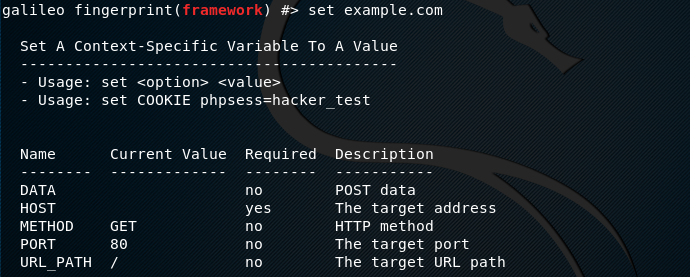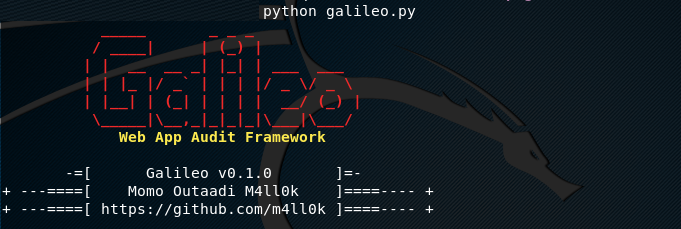Galileo
is a free web application auditing framework that can perform various
penetration testing tasks, such as information gathering,
fingerprinting, bruteforcing, injection test, and exploiting
vulnerabilities. Galileo uses different modules to perform these tasks.
The modules can be divided into following categories.
Bruteforce
Disclosure
Fingerprint
Injection
Scanner
Tools
Exploitation
Bruteforce modules can be used to bruteforce the credentials.
Disclosure modules can find information like credit card data, private
IPs, emails, and source code. Fingerprinting modules can gather
information about Content Management System (CMS), frameworks, and
servers. Injection modules can check the OS command and SQL injection
vulnerabilities in the target web application. Exploitation module can
exploit the errors like shellshock vulnerabilities.
Galileo Installation
Galileo can be cloned from Github repository as follows.
git clone https://github.com/m4ll0k/Galileo.git galileo

To install the requirements, follow the following commands.
cd galileo
python2 -m pip install -r requirements.txt
Galileo Working
To run Galileo, simply type the following command in the terminal.
python2 galileo.py
The command loads list of modules categories, as shown in the following screenshot.

In order to view list of modules, use the following command.
show modules
To use the desired module, type its name in the following format.
use <module name>
For example, to use fingerprint/server module, type the following command.
use fingerprint/server
In order to define the target web application, we need to use the set parameters. The available set parameters can be seen by typing set help command in the terminal.

To define the target web application, we need to use set HOST parameter in the following format.
set HOST <target web application>
To execute the selected module, simply type run in the command line.
run
The module runs and displays the results on the screen as shown below.
We can use all the modules in the same way. For instance, to use the SQL injection, we can use the injection/sq_injection module in the following format
use injection/sql_injection
set HOST <target web application>
run
If the target web application is vulnerable, the module responds with the backend Database Management System (DBMS) information.








Aucun commentaire:
Enregistrer un commentaire